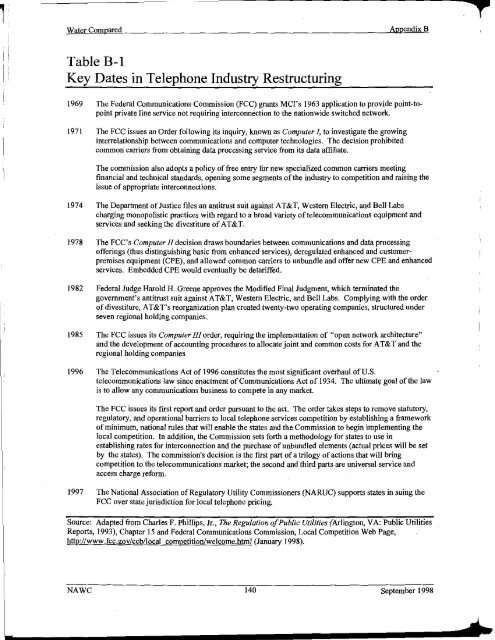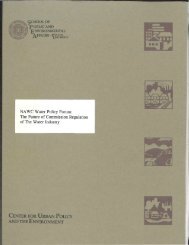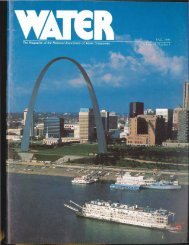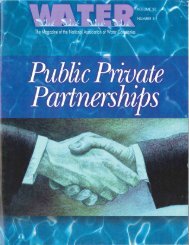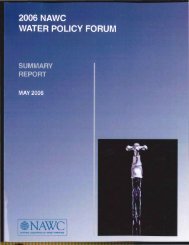BEECHER - NAWC
BEECHER - NAWC
BEECHER - NAWC
You also want an ePaper? Increase the reach of your titles
YUMPU automatically turns print PDFs into web optimized ePapers that Google loves.
Water ComparedAppendixBTable B-1Key Dates in Telephone Industry Restructuring1969 The Federal Communications Commission (FCC) grants MCI's 1963 application to provide point-topointprivate line service not requiring interconnection to the nationwide switched network.1971 The FCC issues an Order following its inquiry, known as Computer I, to investigate the growinginterrelationship between communications and computer technologies. The decision prohibitedcommon carriers from obtaining data processing service from its data affiliate.The commission also adopts a policy of free entry for new specialized common carriers meetingfinancial and technical standards, opening some segments of the industry to competition and raising theissue of appropriate interconnections.1974 The Department of Justice files an antitrust suit against AT&T, Western Electric, and Bell Labscharging monopolistic practices with regard to a broad variety of telecommunications equipment andservices and seeking the divestiture of AT & T.1978 The FCC's Computer II decision draws boundaries between communications and data processingofferings (thus distinguishing basic from enhanced services), deregulated enhanced and customerpremisesequipment (CPE), and allowed common carriers to unbundle and offer new CPE and enhancedservices. Embedded CPE would eventually be detariffed.1982 Federal Judge Harold H. Greene approves the Modified Final Judgment, which terminated thegovernment's antitrust suit against AT&T, Western Electric, and Bell Labs. Complying with the orderof divestiture, AT &T's reorganization plan created twenty-two operating companies, structured underseven regional holding companies.1985 The FCC issues its Computer JJiorder, requiring the implementation of "open network architecture"and the development of accounting procedures to allocate joint and common costs for AT&T and theregional holding companies1996 The Telecommunications Act of 1996 constitutes the most significant overhaul of U.S.telecommunications law since enactment of Communications Act of 1934. The ultima!~ goal of the lawis to allow any communications business to compete in any market.The FCC issues its first report and order pursuant to the act. The order takes steps to remove statutory,regulatory, and operational barriers to local telephone services competition by establishing a frameworkof minimum, national rules that will enable the states and the Commission to begin implementing thelocal competition. In addition, the Commission sets forth a methodology for states to use inestablishing rates for i.nterconnection and the purchase of unbundled elements (actual prices will be setby the states). The commission's decision is the first part of a trilogy of actions that will bringcompetition to the telecommunications market; the second and third parts are universal service andaccess charge reform.!997 The National Association of Regulatory Utility Commissioners (NARUC) supports states in suing theFCC over state jurisdiction for local telephone pricing.Source: Adapted from Charles F. Phillips, Jr., The Regulation of Public Utilities (Arlington, VA: Public UtilitiesReports, 1993), Chapter 15 and Federal Communications Commission, Local Competition Web Page,http://www.fcc.gov/ccb/local competition/welcome.htrnl (January 1998).<strong>NAWC</strong> 140 September 1998


